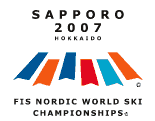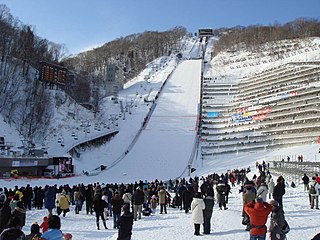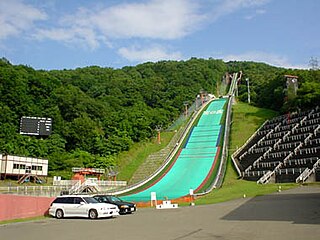
The 1984 Winter Olympics, officially known as the XIV Olympic Winter Games and commonly known as Sarajevo '84, were a winter multi-sport event held between 8 and 19 February 1984 in Sarajevo, Yugoslavia. It was the first Winter Olympic Games held in a Slavic language-speaking country, as well as the only Winter Olympics held in a communist country before the 2022 Winter Olympics in Beijing, China. It was the second consecutive Olympic Games held in a communist country, after the 1980 Summer Olympics in Moscow, Russian SFSR, Soviet Union.
The 1972 Winter Olympics, officially the XI Olympic Winter Games [dai dʑɯitɕi-kai oɾinpikɯ tokikʲogi taikai] and commonly known as Sapporo 1972, were a winter multi-sport event held from February 3 to 13, 1972, in Sapporo, Hokkaido Prefecture, Japan. It was the first Winter Olympic Games to take place outside Europe and North America.

Simon Ammann is a Swiss ski jumper. He is one of the most successful athletes in the history of the sport, having won four individual Winter Olympic gold medals in 2002 and 2010. His other achievements include winning the 2007 Ski Jumping World Championships, the 2010 Ski Flying World Championships, the 2010 Nordic Tournament, and the 2010 Ski Jumping World Cup overall title.

Bjørn Tore Wirkola is a Norwegian former ski jumper.
Nordic combined at the 1972 Winter Olympics consisted of one event, held from 4 February to 5 February. The ski jumping portion took place at Miyanomori Ski Jump Stadium, while the cross-country portion took place at Makomanai Park.
Ski jumping at the 1972 Winter Olympics consisted of two events held from 6 to 11 February 1972, with the large hill event taking place at Okurayama Ski Jump Stadium, and the normal hill event at Miyanomori Ski Jump Stadium.

Jiří Raška was a Czechoslovakian ski jumper. He is regarded as the most famous Czech ski jumper of the 20th century.

Kazuyoshi Funaki is a Japanese former ski jumper. He ranked among the most successful sportsmen of its discipline, particularly in the 1990s. Funaki is known for his special variant of the V-style, in which the body lies flatter between the skis than usual.

The FIS Nordic World Ski Championships 2007 took place 22 February – 4 March 2007 in Sapporo, Japan. It was the second time this city has hosted these championships, having previously done so in the 1972 Winter Olympics. Sapporo was selected as venue by vote at the 43rd FIS World Congress in Portorož, Slovenia, on 6 June 2002. It also marked the third time the championships were hosted outside Europe in a year that did not coincide with the Winter Olympics; it was the first championship held in Asia. The ski jumping team normal hill event was not held, as it had been in 2005.
The Nordic combined at the FIS Nordic World Ski Championships 2007 took place at the FIS Nordic World Ski Championships 2007 in Sapporo, Japan on February 23, February 25, and March 3, 2007.
The ski jumping at the FIS Nordic World Ski Championships 2007 was part of the FIS Nordic World Ski Championships 2007 that took place in Sapporo, Japan, on February 24, February 25, and March 3, 2007.

Kamil Wiktor Stoch is a Polish ski jumper. He is one of the most successful ski jumpers in the history of the sport, having won two World Cup titles, three Four Hills Tournaments, three individual gold medals at the Winter Olympics, individual and team gold at the Ski Jumping World Championships, and individual silver at the Ski Flying World Championships. His other tournament wins include Raw Air (twice), the Willingen Five, and Planica7.
Tauno Olavi Käyhkö is a Finnish-Canadian former ski jumper who competed from 1970 to 1980. At the 1972 Winter Olympics in Sapporo, he finished fourth in the individual large hill event.

The Ōkurayama Ski Jump Stadium, also known as the Ōkurayama-Schanze is a ski jumping venue located in the Miyanomori area in Chūō-ku, Sapporo, Hokkaidō, Japan. Owned mostly by Sapporo City, the ski jump is on the eastern slope of the Mt. Okura. The stadium has hosted a number of winter sports events including 1972 Winter Olympics and FIS Nordic World Ski Championships 2007. The area of stadium consists of the Winter Sports Museum, the Ōkurayama Crystal House, and the Mt. Okura Observation Platform, as well as the ski jump.

The women's 30 kilometre classical cross-country skiing competition at the 2010 Winter Olympics in Vancouver, Canada was held on 27 February at Whistler Olympic Park in Whistler, British Columbia at 11:45 PST.
For the 1972 Winter Olympics in Sapporo, Japan, a total of twelve sports venues were used. A thirteenth venue which was a reserved luge course was constructed, but never used in actual competition. Construction on all of the venues used took place between 1968 and early 1971 in time for the test events. The Tsuskisamu Indoor Skating Rink was not completed until late 1971 or early 1972 because the number of teams scheduled to compete at the 1972 Games was not known. At the actual luge venue used, a malfunctioning starting gate during the first run led to the results being cancelled and rerun being ordered. The results of this event led to the only tie in Olympic luge history. The ski jumps at Miyanomori and Okurayama served as host venues for the FIS Nordic World Ski Championships thirty-five years later.

The Miyanomori Ski Jump Stadium, also known as the Miyanomori-Schanze is a ski jumping venue located in the Miyanomori area in Chūō-ku, Sapporo, Hokkaidō, Japan. The stadium has hosted a number of winter sports events including 1972 Winter Olympics and FIS Nordic World Ski Championships 2007.

Robert Høneren Johansson is a Norwegian ski jumper. He is a former ski flying world record holder, having landed a jump of 252 m (827 ft) in Vikersund on 18 March 2017. Johansson has often been nicknamed the "Wing Commander" for his distinctive handlebar moustache.
Ski jumping at the 1986 Asian Winter Games took place in the city of Sapporo, Japan on 2 March 1986 with only one event, Large hill individual being contested. The Olympic Council of Asia General Assembly in Seoul in 1984 decided to give Japan the privilege of hosting the first ever Asian Winter Games. The event was only for demonstration; the medals gained here did not officially count towards the final medal tally.
Ski jumping at the 1990 Asian Winter Games took place in the city of Sapporo, Japan on 14 March 1990 with only one event, Large hill individual being contested. India was originally scheduled to host the second edition of the games, but due to technical and financial difficulties, it gave up its hosting rights to Japan in 1989. The event was only for demonstration; the medals gained here did not officially count towards the final medal tally.












